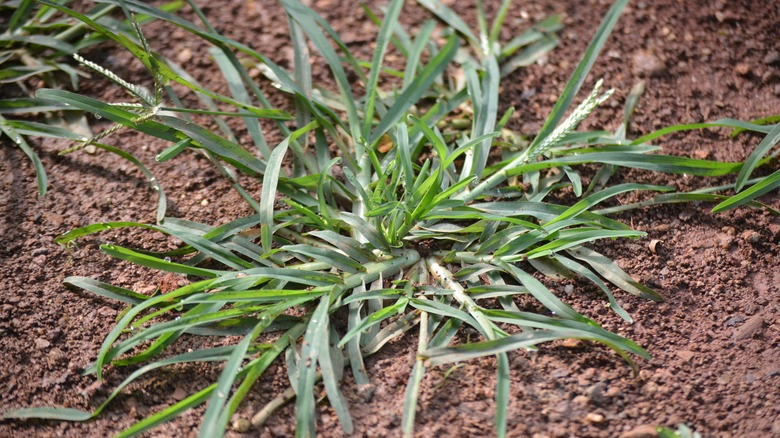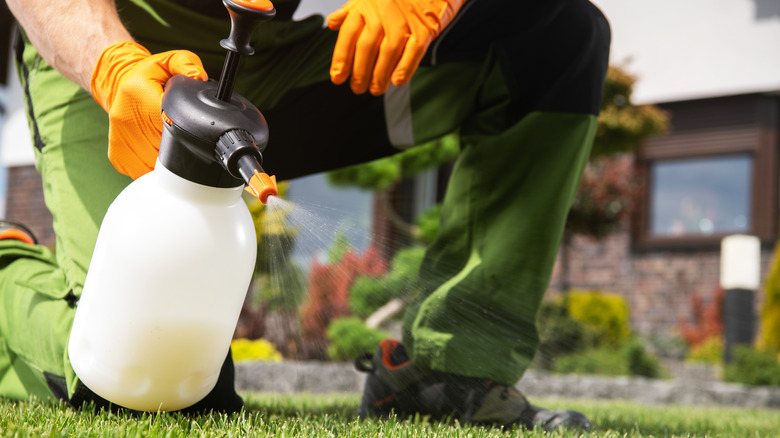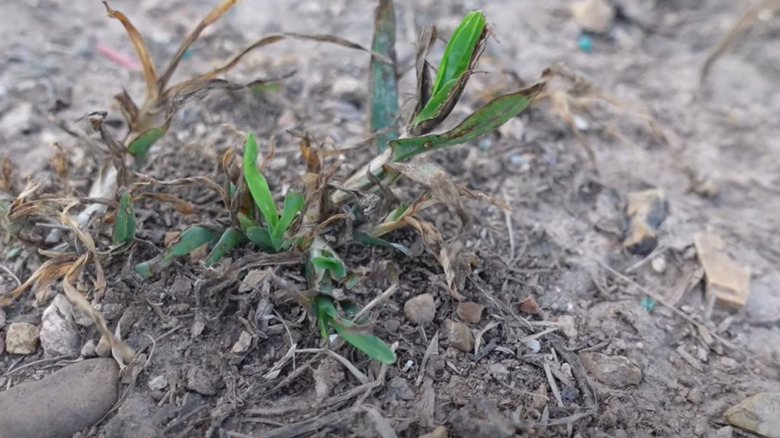Fight Off Goosegrass In Your Yard With One Common Household Ingredient
We may receive a commission on purchases made from links.
Picture a tufted green invader that radiates from the center in a star-like pattern and loves compacted soil making its home in your yard. It's goosegrass, also known as wiregrass or crowfootgrass. Left to thrive, this fast-growing weed can steal the beauty from your outdoor sanctuary, in addition to triggering intense competition for nutrients your ornamental plants crave. When it comes to controlling goosegrass in your yard, you don't have to reach out for that conveniently shelved bottle of synthetic herbicide. Some solutions in Mother Nature's laboratory are equally (if not more) potent against weeds in your yard, without collateral damage to your health and the environment. Enter the hero of today's story, a household staple often found in kitchen cabinets: vinegar.
Diving into the science of it, white vinegar's secret weapon against weeds is acetic acid. When sprayed onto the pesky plants, it sucks the life right out of them — literally. Per Montana State University, the acid works by damaging the plant cell's lining, setting in motion a destructive sequence that eventually dehydrates the weed. The evidence is the burns you notice on the sprayed leaves. White vinegar is particularly harmful to young goosegrass. Yet, as with any other weapon, several precautions should be taken to prevent harm to yourself or your desired plants. Apply it correctly, and you'll revel in an inexpensive, eco-friendly solution to those goosegrass worries.
How to kill goosegrass with white vinegar
When contemplating this method of goosegrass control, understand that not just any vinegar will do. Horticultural vinegar with an acetic acid concentration between 20% and 45% is best, with a worthy recommendation being TradeKing 30% Vinegar on Amazon. Your weapon? A concoction of a gallon of distilled vinegar, a tablespoon of dish soap, and a cup of table salt. Salt will ensure the weeds wither in dehydration, while soap plays the part of a surfactant, ensuring vinegar clings to the leaves.
However, don't walk blindfolded into battle; protecting innocent plant bystanders is essential. Use a piece of cardboard or plastic sheeting to protect desirable vegetation from stray vinegar splashes. And when it comes to application, let it be careful and selective. A spray bottle suffices here to facilitate precise targeting, ensuring a thorough coating of vinegar on the goosegrass while sparing surrounding plants. You can even fine-tune the spray nozzle to jet steady streams, preventing misty misfires.
Just as in cooking, timing is everything when using vinegar as a weed killer. The perfect day to unleash the botanical justice is sunny, with temperatures above 70 degrees Fahrenheit. In addition, don't apply the vinegar before an anticipated rain, lest your efforts get washed away. Monitoring the battlefield is crucial, and if the goosegrass hasn't wilted after several days, charge again with more vinegar. Once you've secured victory, carefully dispose of the remnants — you don't want those vengeful seeds plotting a resurgence.
Caveats for eliminating goosegrass with vinegar
Like any powerful weapon, vinegar must be handled with care. Armed with acetic acid, it can irritate your skin and eyes upon direct contact, so cover up with a solid pair of gloves and protective eyewear. You must also pay attention to the strength of your vinegar, as the potency varies. A 5% concentration may cause minor eye annoyance, but a 20% solution could be an absolute beast, potentially causing harsh chemical burns. Vinegar won't necessarily slay the goosegrass roots, necessitating additional rounds. However, resist the temptation to overuse your vinegar arsenal; plan your attacks biweekly. That's because regular exposure to acetic acid can wreak havoc on your dental enamel and lead to bronchitis (per the University of Maryland). Speaking of collateral damage from vinegar solution, protect your desirable plants but also masonry and metallic structures or furniture in your yard.
Battle won? Don't toss out your leftover vinegar solution. Decant it into a clean container, label it (for it could easily be mistaken for a salad dressing component), and store it in a cool, dry place for future skirmishes. This potent potion should not be stored in the kitchen, to avoid being confused with food.
Finally, hand-pulling, while not as satisfying as the vinegar onslaught, may be your best option for controlling goosegrass on your lawn. That will save your cherished turf from the non-selective vinegar attack.


